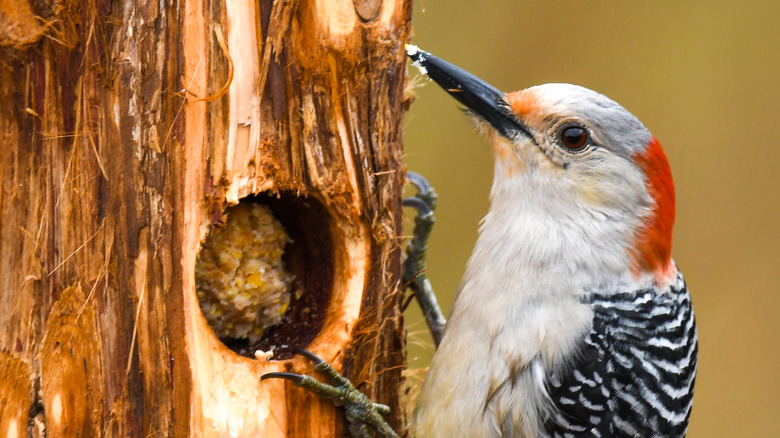While you might think most birds fly south at the first sign chilly weather, in many areas of the country a number stick around to overwinter including northern cardinals and several types of jays. When it comes to keeping birds energized and fed during periods when usual munchies like seeds and insects aren’t plentiful, they appreciate a good batch of suet. You can easily hang up a suet cage, we have an even better idea for you: A log feeder with multiple holes to hold suet.
Log feeders come in a variety of types when you buy them pre-made. Some are crafted of wood while others employ recycled plastics that simulate wood. Instead of buying one, however, you can make a log feeder that looks inviting to avian visitors frequenting your yard and very natural among the branches of your trees.
Provided you already have an electric drill and the right type of bit, making your own using a discarded log will help you save a few bucks, too, since pre-made feeders like these usually sell in the $15-40 range. You might even want to hang several of these to give more birds an opportunity to feed, so even if you invest some money in supplies like a drill bit and eye screws, you can still come out way ahead versus buying a few ready-made feeders.
How to make a suet log bird feeder
The first thing you’ll need is a log about 2 feet long and 2 1/2 inches to 3 inches in diameter. You can remove any knots on the log with a small ax, if needed, so it will be more stable when you get ready to drill holes into it. Backyard Birds on YouTube also suggests removing the bark from the log to help more species of birds be able to grasp it and feed.
To drill the holes to hold your suet, you’ll need either a 1-inch forstner bit or a 1-inch spade bit. Using a drill press can make the job easier, but you can also use an electric handheld drill. A good rule to follow is drilling the first hole a few inches from the top of your log about 1 inch deep. Then make a quarter turn and drill another one. Repeat the process until you have holes all around the log.
The final thing you’ll need to do is add an eye screw to the log so you can hang it. Using your power drill and a small bit, drill a pilot hole in the top of the log and guide the screw in by hand. Then you can insert a screwdriver through the eye for leverage and finish screwing it all the way in. After that, your log feeder will be ready to fill with suet and hang.
Filling your log feeder with suet

To make up a batch of suet to fill your log feeder, you can use the same basic recipe you’d use to DIY a suet block. In fact, if you have some suet blocks in your freezer already made, thaw one out, cut it up into small chunks, and press them into the holes of your log feeder. Wearing disposable gloves is a good idea, since filling the holes can get a bit messy.
No suet on hand? Not a problem. Making up a batch is easy. A good recipe to follow is combining one cup bird seed, 1/2 cup dried fruit, 1/2 cup peanuts, and one cup of oats along with one cup melted lard or rendered fat (using fat available from your local butcher counter). Mix the ingredients together, and after the mixture cools you can roll your suet into small balls to fill the holes in your log feeder.
Among the different species of overwintering birds are downy woodpeckers, and they’re known to frequent log feeders — especially when you add some dried mealworms from your local pet supply store to your suet mix. You may even find serving up suet in a log like this will keep birds at your feeders longer than you anticipated for a winter birding treat.




